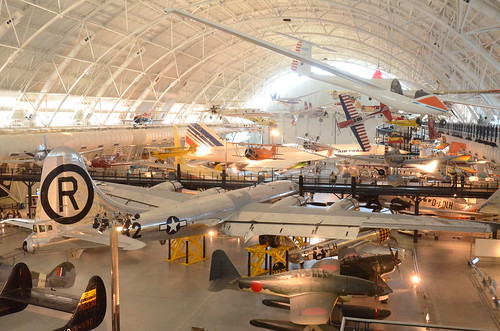Steven F. Udvar-Hazy Center: View of south hangar, including B-29 Superfortress “Enola Gay”, a glimpse of the Air France Concorde, and many others
Image by Chris Devers
Quoting Smithsonian National Air and Space Museum | Boeing B-29 Superfortress "Enola Gay":
Boeing’s B-29 Superfortress was the most sophisticated propeller-driven bomber of World War II and the first bomber to house its crew in pressurized compartments. Although designed to fight in the European theater, the B-29 found its niche on the other side of the globe. In the Pacific, B-29s delivered a variety of aerial weapons: conventional bombs, incendiary bombs, mines, and two nuclear weapons.
On August 6, 1945, this Martin-built B-29-45-MO dropped the first atomic weapon used in combat on Hiroshima, Japan. Three days later, Bockscar (on display at the U.S. Air Force Museum near Dayton, Ohio) dropped a second atomic bomb on Nagasaki, Japan. Enola Gay flew as the advance weather reconnaissance aircraft that day. A third B-29, The Great Artiste, flew as an observation aircraft on both missions.
Transferred from the United States Air Force.
Manufacturer:
Boeing Aircraft Co.
Martin Co., Omaha, Nebr.
Date:
1945
Country of Origin:
United States of America
Dimensions:
Overall: 900 x 3020cm, 32580kg, 4300cm (29ft 6 5/16in. x 99ft 1in., 71825.9lb., 141ft 15/16in.)
Materials:
Polished overall aluminum finish
Physical Description:
Four-engine heavy bomber with semi-monoqoque fuselage and high-aspect ratio wings. Polished aluminum finish overall, standard late-World War II Army Air Forces insignia on wings and aft fuselage and serial number on vertical fin; 509th Composite Group markings painted in black; "Enola Gay" in black, block letters on lower left nose.
According to a recent issue of Aerospace Engineering and Manufacturing, “Tough-minded offshore competitors, currency swings, trade disputes, and customer balance sheet fluctuations created by anything from the financial crisis to Icelandic volcanic activity are just a few of the external factors that can determine success or failure for the North American manufacturing industry.”
The Memex Automation Mx2000 Machine Interface handheld device is connected to the machine control panel and to the Ax9150 UMI for OEE Machine Monitoring (physically located inside the panel). This Memex Automation structure allows signals to be picked up automatically from the machine, eliminating operator input as much as possible, but if the operator needs to enter information, the operator has that ability as well.
Inside the factory walls, all that matters is productivity.
“The cost of raw materials is essentially the same for all machined part manufacturers, and the cost of capital equipment is about the same,” said Sébastien Caron, Plant Manager for Héroux-Devtek Inc. “Even quality is becoming much the same. So our biggest differentiator is productivity.”
Héroux-Devtek manufactures aircraft landing gear, aerostructures, and industrial components in 10 locations across North America. Like most manufacturing headquarters, the Longueuil, Québec, head office is a paragon of computerized productivity. Centralized, Internet-driven networks control flows of information via enterprise resource planning (ERP) systems, accounting systems, and communications systems that help run the company.
Until teaming up with Burlington, Ontario-based Memex Automation, it was a different story on the factory floor. Individual machine tools were highly automated, but as in many manufacturing operations they remained islands of unconnected information—like having a group of office PCs, each with a different software application, unconnected by a Local Area Network, and unable to communicate with each other.
The company decided to change that. In 2007, it initiated a companywide mandate to look at overall equipment effectiveness (OEE) devices that automatically track machine utilization. With a mechanical engineering and project management background, as well as experience working in several of Héroux-Devtek’s manufacturing sites, Caron was put in charge of the project.
“I knew that there were other Héroux-Devtek sites looking at OEE devices to track machine utilization,” he said. “Many of our plants were working towards individual implementations. Some sites were ahead, other sites had not started at all. We realized that it would be beneficial to have a common OEE platform for all sites. After talking to all our plant managers, we decided on a common approach. Dedicated individuals from each site worked in collaboration to successfully implement the Memex product, taking into account their specific operational environments.
About Memex Automation Inc.
Memex Automation Inc., http://www.memex.ca, a unit of Astrix Networks Inc., was created to leverage the research and development of Memex Electronics, which was founded in 1992. Memex continues its tradition of serving the discrete manufacturing sector, supplying component hardware, memory upgrades, and visionary shop floor communication technology. Memex Automation products are “Automating the Automation” allowing a manufacturer to increase productivity and decrease costs. Memex Automation focuses on delivering value with Real-Time Machine Monitoring and Control, which utilizes OEE+DNC solutions that boost efficiency by up to fifty percent with minimal capital investment. Memex Automation is based in Burlington, Ontario.
Memex, Inc.
www.memex.ca
John Rattray
jrattray@astrixnet.com
1-866-573-3895
Professional Marketing Firm for the Manufacturing Community. Manufacturing Journalist or Contributing Journalist for many manufacturing magazines and journals. Founder of the Media Consortium and media blitz.
Memex Automation OEE Solution Discussed in Aerospace Engineering and Manufacturing
Nessun commento:
Posta un commento